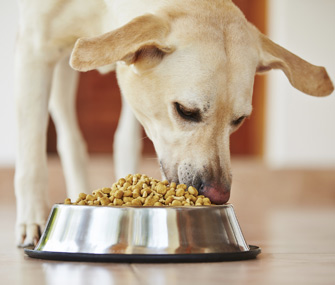An Overfeeding Obsession? The Human Psyche and the Pet Obesity Epidemic
Published on September 23, 2014
Skip To

If you’re guilty of this behavior, you’re in good company. You’re in a club that’s currently growing, uncontrolled, as we Americans feel the urge to offer more and more tidbits to our beloved creatures. This desire has spawned an industry of animal snacks.
Twenty years ago you would have thought the market saturated. There were crunchy “bones,” improbably hued meat morsels and chewy strips –– all designed to appeal more to the human in us than the animal in them. But that was the extent of it. Today’s pet owner, by contrast, heads to an entire aisle of offerings, an explosion of selections I imagine our ancestors would’ve stared at, open-mouthed and aghast.
What’s Behind the Feeding Frenzy?
I’ve had cause to think about this — a lot. I believe that if I can plumb the depths of the American psyche and pinpoint a cause behind this "feeding frenzy," I’ll perhaps earn a Nobel Prize (or a MacArthur Grant). At the very least, knowing more about our culture’s compulsion to overfeed might bear fruit in my exam room.What is it about humans that makes us feel the need to feed everything? It’s as if there’s a reflex somewhere in our circuits that connects another being with the irrepressible desire to see it eat.
Think I exaggerate?
Zoos sharply instruct visitors to refrain from feeding some animals while placing kibble dispensers in front of others, as if to satisfy our overwhelming urge to gorge a display’s nonhuman inhabitants. And feeding time at the zoo remains the main attraction.
Wildlife sanctuaries and parks have to warn people against throwing their half-consumed fried chicken and other picnic detritus to the animals.
Feeding pigeons and ducks at parks and lakes is considered a bucolic pastime.
Wildlife programming on television is rife with predator-prey interactions, shark-feeding scenarios and other such gastronomic delights.
See what I mean?
Are Vets Fighting an Uphill Battle?
There are more obvious examples to consider, such as the feeding of community cats. Feeding felines on a back porch or in a parking lot is a way of life for some. Is this pure charity? Perhaps. But it may also nourish an obsession to feed an animal every bit as much as the stuffing of one’s personal pets to obese proportions.Why else would a fat pet be considered socially acceptable enough to shift the "normal" for many breeds toward greater thickness? Why else would thinner pets get clucked over as if they were the sickly ones?
Perhaps this is just American culture. Given that the United States ranked first on the list of most obese countries in a recent study published in The Lancet, the rest of the world may not live with this all-you-can-eat mentality and our dietary obsessions. The rest of humanity may not spend a lazy day feeding cheese food laced with more cheese food to an iguana. (I saw this in action recently in the Florida Keys.) No, this probably doesn’t even occur to most humans outside this country’s four corners.
This impulse to feed things is exactly what I’m up against in my veterinary practice. It’s no wonder that imparting a sense of urgency to the need for weight loss in pets seems so Sisyphean. After all, the obesity epidemic in pets will be depressingly difficult to counter if we all harbor an innate desire to smear Cheez Whiz on a Dorito and feed it to an animal.
More on Vetstreet.com:
- 10 Dangerous Human Foods for Pets
- Why Good Owners Let Their Pets Gain Weight
- 13 Friendliest Dog Breeds
- Pet Food Protein: Why It is Very Important for Your Cat and Dog





